Abstract
1. The effects of adenosine and a range of adenosine analogues, which are resistant to uptake processes, were studied in the presence of dihydropyridines and verapamil on the population spike potential recorded from the CA1 area of the hippocampal slice. 2. Nifedipine and Bay K 8644, a calcium channel antagonist and activator respectively, enhanced the inhibitory action of adenosine in a concentration-dependent manner. This was in contrast to their effect on adenosine analogues where the inhibition of the population potential was significantly attenuated. Similar interactions between the adenosine compounds and the dihydropyridines were also displayed in studies on spontaneous epileptiform activity in the CA3 region. 3. This effect of nifedipine and Bay K 8644 was not shown by the dihydropyridines, nimodipine or nitrendipine, or by the phenylalkylamine, verapamil. 4. Addition of the adenosine uptake blocker dipyridamole reversed the action of nifedipine on adenosine, so that inhibition by adenosine was now attenuated by nifedipine in a similar manner to that observed with the adenosine analogues. 5. These results can be explained with reference to binding studies that show displacement of adenosine analogues from the adenosine receptor by dihydropyridines. An action at the adenosine uptake site by the dihydropyridines explains the enhancement of adenosine inhibition. 6. The possible sites for this interaction are discussed.
Full text
PDF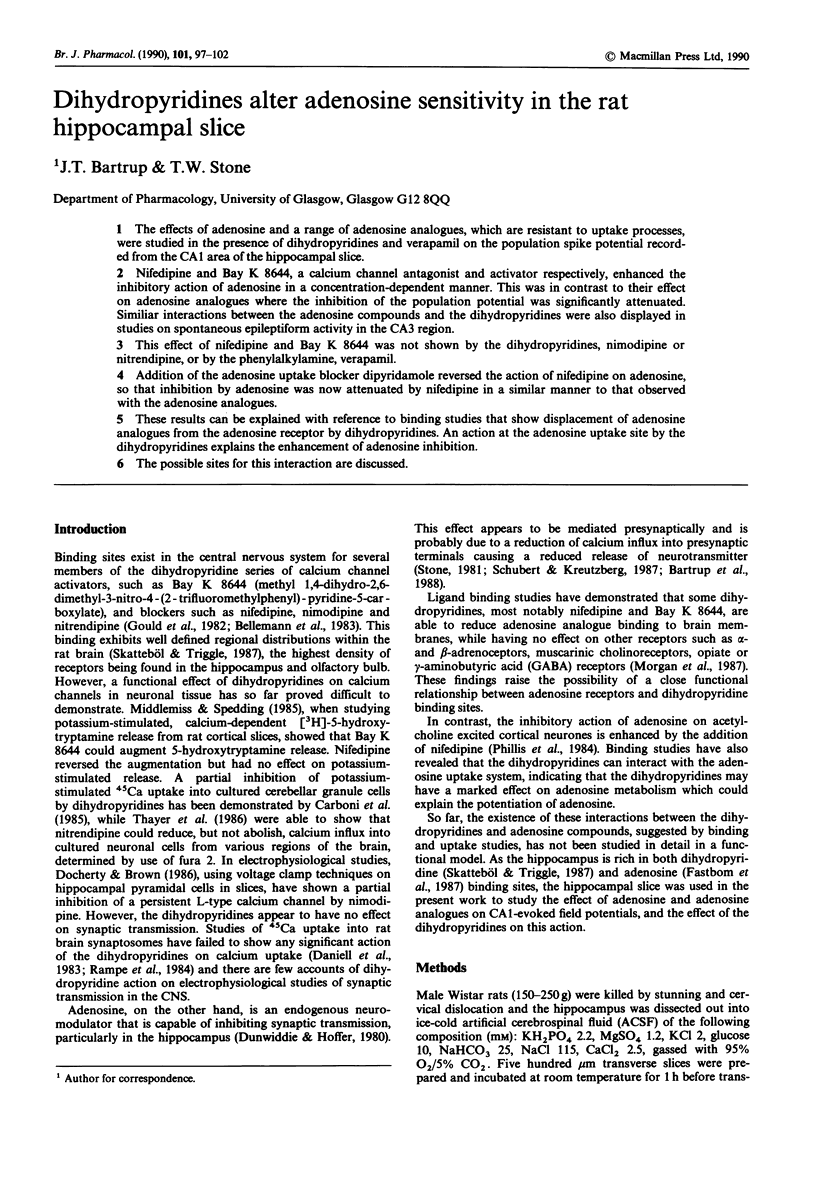
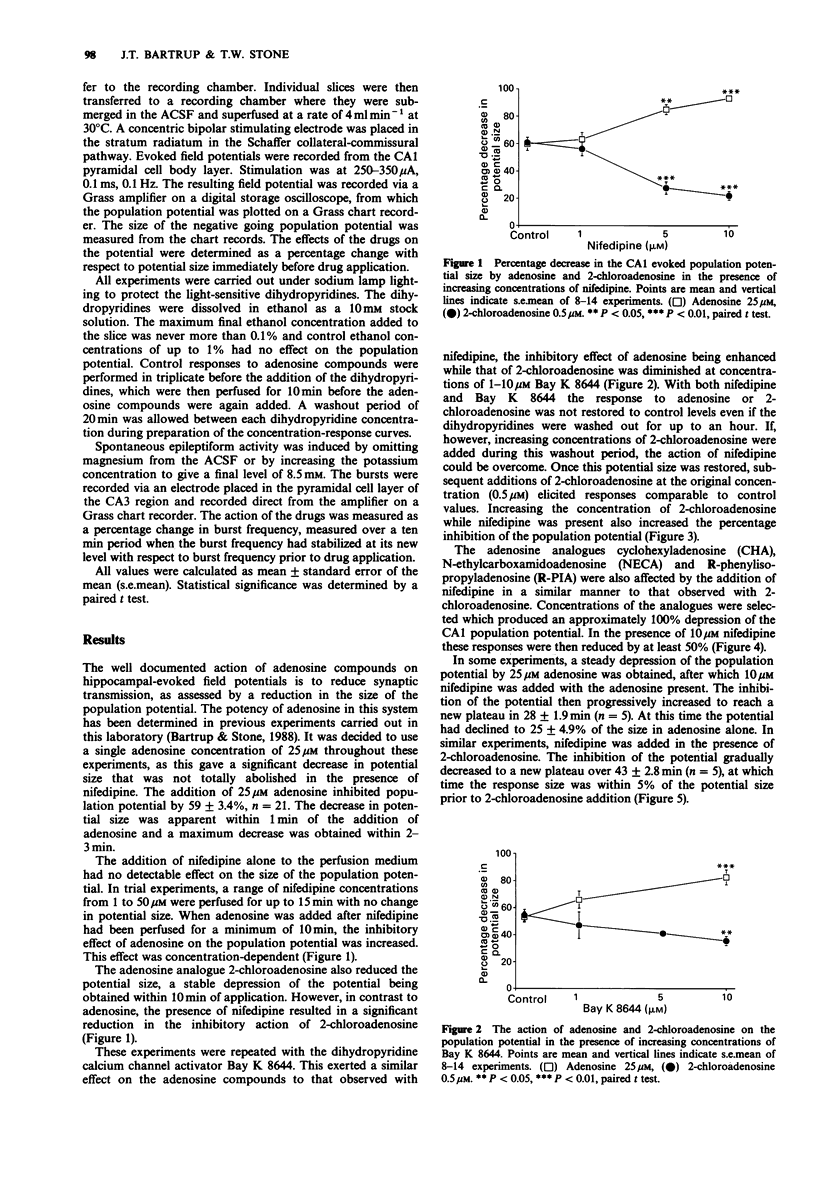
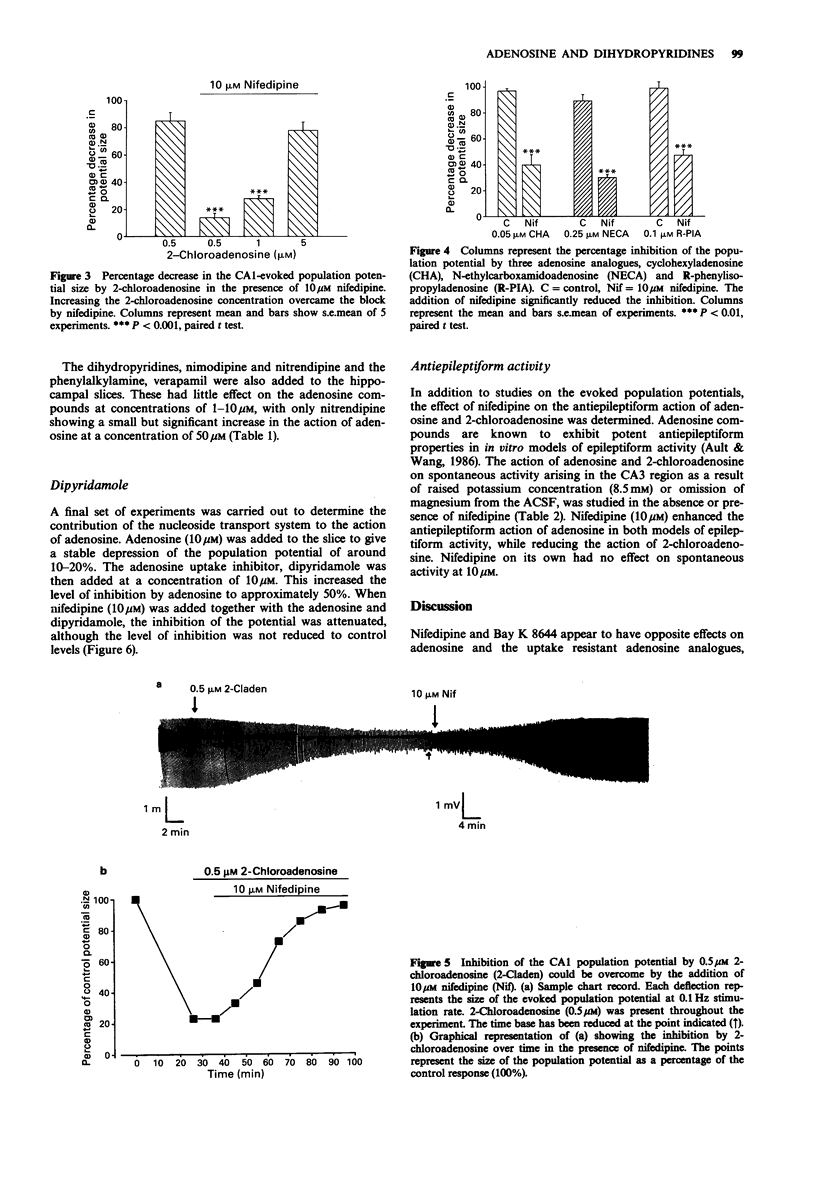
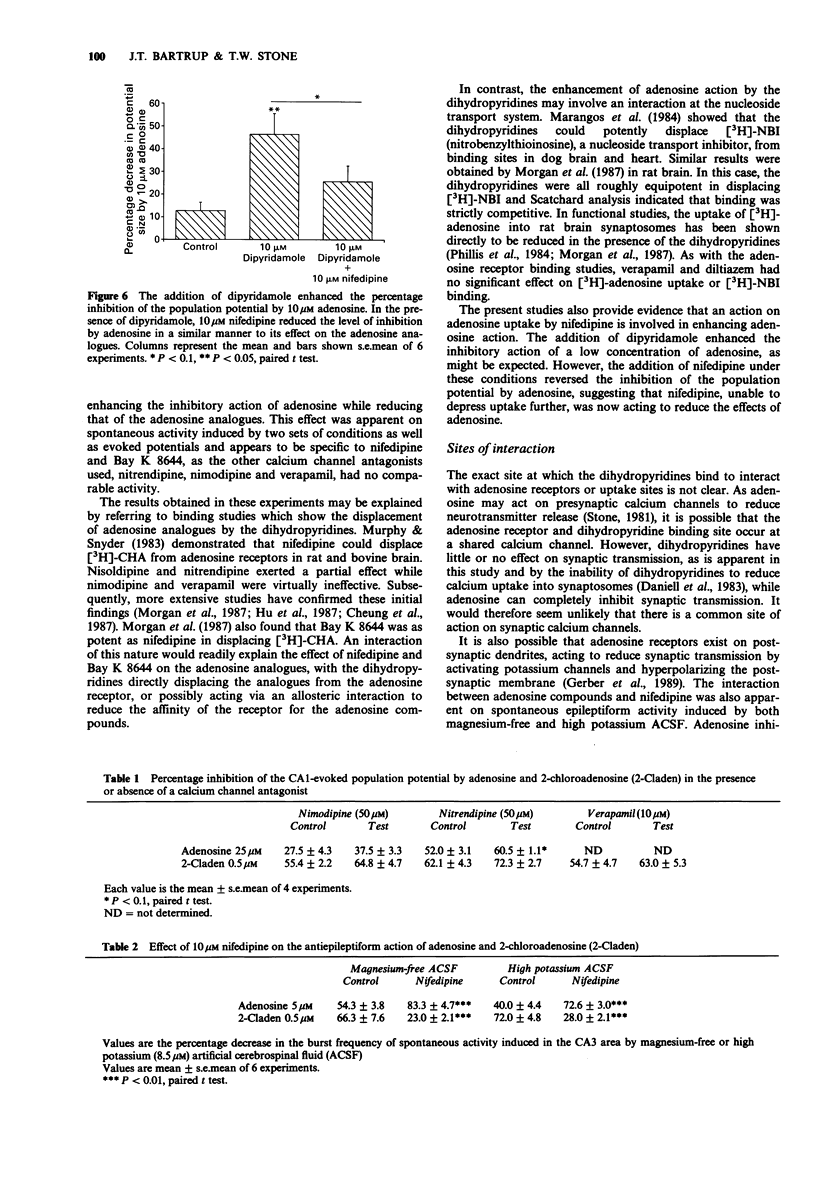
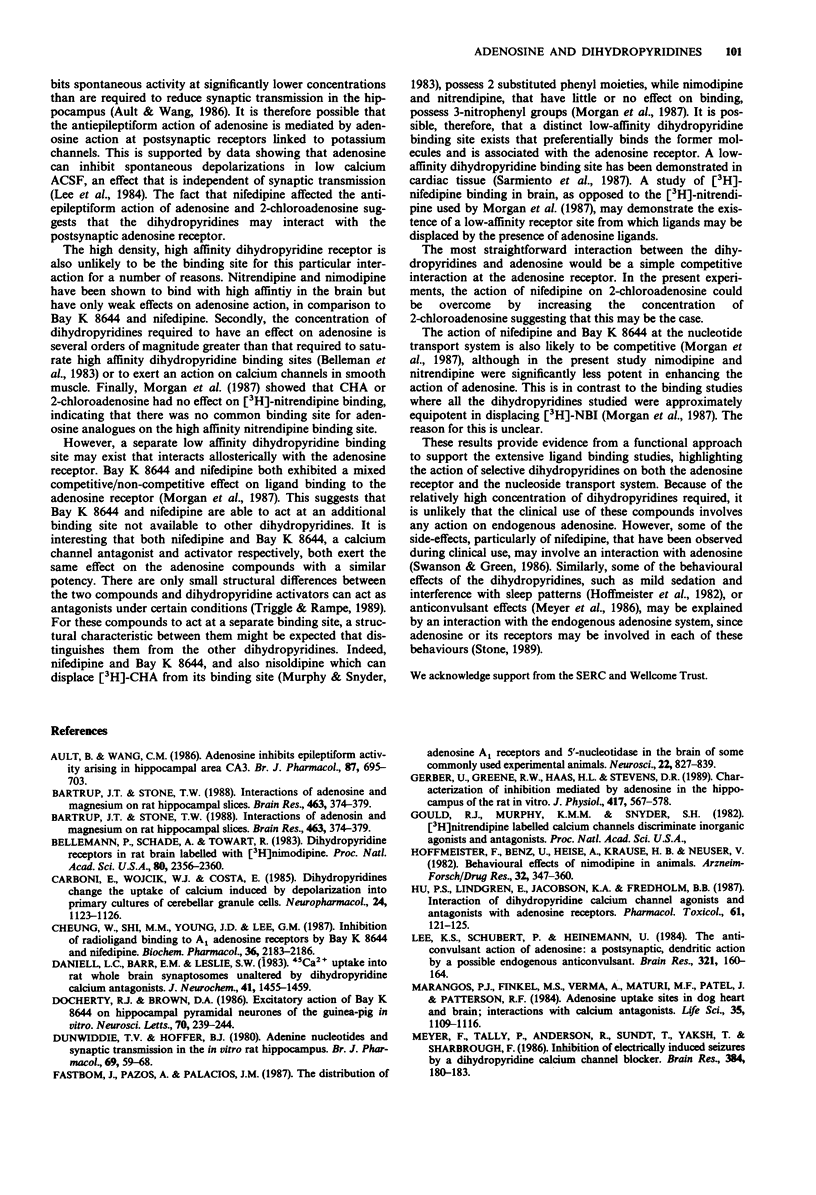
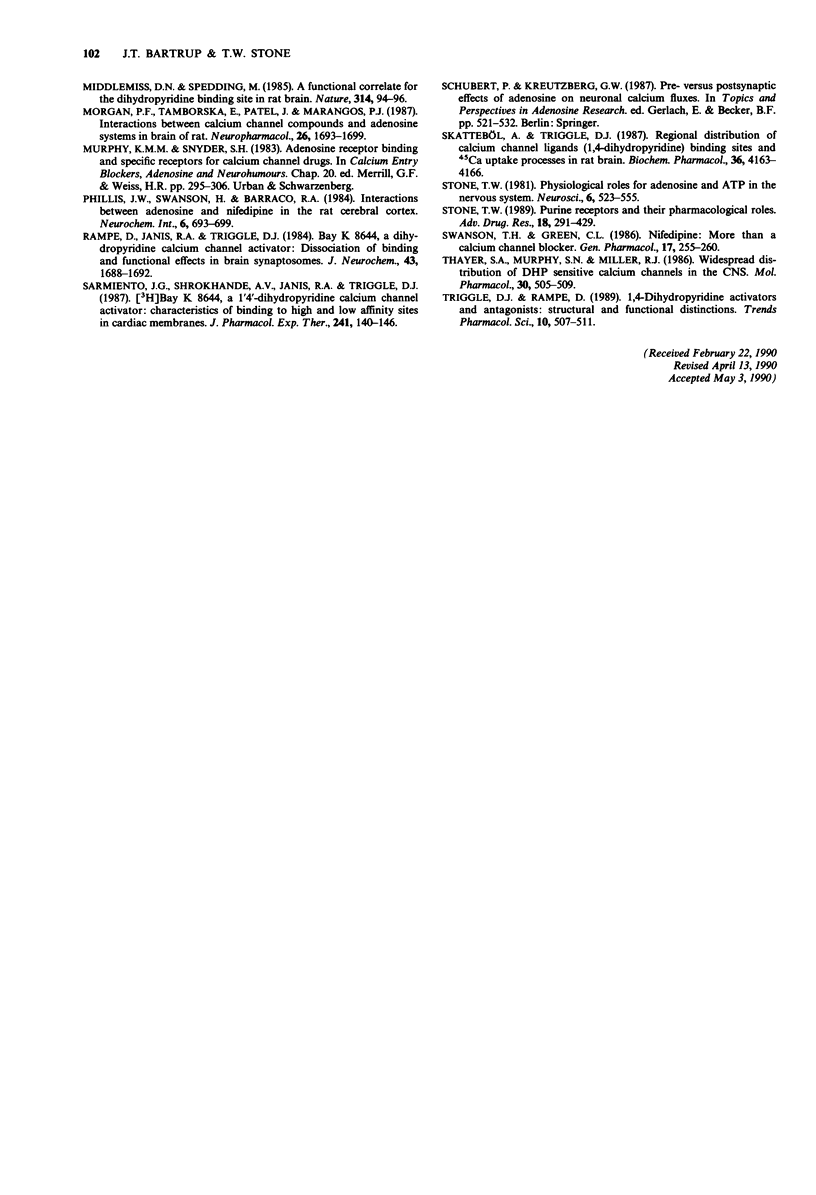
Selected References
These references are in PubMed. This may not be the complete list of references from this article.
- Ault B., Wang C. M. Adenosine inhibits epileptiform activity arising in hippocampal area CA3. Br J Pharmacol. 1986 Apr;87(4):695–703. doi: 10.1111/j.1476-5381.1986.tb14587.x. [DOI] [PMC free article] [PubMed] [Google Scholar]
- Bartrup J. T., Stone T. W. Interactions of adenosine and magnesium on rat hippocampal slices. Brain Res. 1988 Nov 1;463(2):374–379. doi: 10.1016/0006-8993(88)90413-1. [DOI] [PubMed] [Google Scholar]
- Bellemann P., Schade A., Towart R. Dihydropyridine receptor in rat brain labeled with [3H]nimodipine. Proc Natl Acad Sci U S A. 1983 Apr;80(8):2356–2360. doi: 10.1073/pnas.80.8.2356. [DOI] [PMC free article] [PubMed] [Google Scholar]
- Carboni E., Wojcik W. J., Costa E. Dihydropyridines change the uptake of calcium induced by depolarization into primary cultures of cerebellar granule cells. Neuropharmacology. 1985 Nov;24(11):1123–1126. doi: 10.1016/0028-3908(85)90202-3. [DOI] [PubMed] [Google Scholar]
- Cheung W. T., Shi M. M., Young J. D., Lee C. M. Inhibition of radioligand binding to A1 adenosine receptors by Bay K8644 and nifedipine. Biochem Pharmacol. 1987 Jul 1;36(13):2183–2186. doi: 10.1016/0006-2952(87)90148-1. [DOI] [PubMed] [Google Scholar]
- Daniell L. C., Barr E. M., Leslie S. W. 45Ca2+ uptake into rat whole brain synaptosomes unaltered by dihydropyridine calcium antagonists. J Neurochem. 1983 Nov;41(5):1455–1459. doi: 10.1111/j.1471-4159.1983.tb00845.x. [DOI] [PubMed] [Google Scholar]
- Docherty R. J., Brown D. A. Excitatory action of BAYK8644 on hippocampal pyramidal neurones of the guinea pig in vitro. Neurosci Lett. 1986 Oct 8;70(2):239–244. doi: 10.1016/0304-3940(86)90470-2. [DOI] [PubMed] [Google Scholar]
- Dunwiddie T. V., Hoffer B. J. Adenine nucleotides and synaptic transmission in the in vitro rat hippocampus. Br J Pharmacol. 1980 May;69(1):59–68. doi: 10.1111/j.1476-5381.1980.tb10883.x. [DOI] [PMC free article] [PubMed] [Google Scholar]
- Gerber U., Greene R. W., Haas H. L., Stevens D. R. Characterization of inhibition mediated by adenosine in the hippocampus of the rat in vitro. J Physiol. 1989 Oct;417:567–578. doi: 10.1113/jphysiol.1989.sp017819. [DOI] [PMC free article] [PubMed] [Google Scholar]
- Hoffmeister F., Benz U., Heise A., Krause H. P., Neuser V. Behavioral effects of nimodipine in animals. Arzneimittelforschung. 1982;32(4):347–360. [PubMed] [Google Scholar]
- Hu P. S., Lindgren E., Jacobson K. A., Fredholm B. B. Interaction of dihydropyridine calcium channel agonists and antagonists with adenosine receptors. Pharmacol Toxicol. 1987 Aug;61(2):121–125. doi: 10.1111/j.1600-0773.1987.tb01788.x. [DOI] [PMC free article] [PubMed] [Google Scholar]
- Lee K. S., Schubert P., Heinemann U. The anticonvulsive action of adenosine: a postsynaptic, dendritic action by a possible endogenous anticonvulsant. Brain Res. 1984 Oct 29;321(1):160–164. doi: 10.1016/0006-8993(84)90694-2. [DOI] [PubMed] [Google Scholar]
- Marangos P. J., Finkel M. S., Verma A., Maturi M. F., Patel J., Patterson R. E. Adenosine uptake sites in dog heart and brain; interaction with calcium antagonists. Life Sci. 1984 Sep 3;35(10):1109–1116. doi: 10.1016/0024-3205(84)90076-6. [DOI] [PubMed] [Google Scholar]
- Meyer F. B., Tally P. W., Anderson R. E., Sundt T. M., Jr, Yaksh T. L., Sharbrough F. W. Inhibition of electrically induced seizures by a dihydropyridine calcium channel blocker. Brain Res. 1986 Oct 1;384(1):180–183. doi: 10.1016/0006-8993(86)91236-9. [DOI] [PubMed] [Google Scholar]
- Middlemiss D. N., Spedding M. A functional correlate for the dihydropyridine binding site in rat brain. Nature. 1985 Mar 7;314(6006):94–96. doi: 10.1038/314094a0. [DOI] [PubMed] [Google Scholar]
- Morgan P. F., Tamborska E., Patel J., Marangos P. J. Interactions between calcium channel compounds and adenosine systems in brain of rat. Neuropharmacology. 1987 Dec;26(12):1693–1699. doi: 10.1016/0028-3908(87)90119-5. [DOI] [PubMed] [Google Scholar]
- Rampe D., Janis R. A., Triggle D. J. BAY K 8644, a 1,4-dihydropyridine Ca2+ channel activator: dissociation of binding and functional effects in brain synaptosomes. J Neurochem. 1984 Dec;43(6):1688–1692. doi: 10.1111/j.1471-4159.1984.tb06096.x. [DOI] [PubMed] [Google Scholar]
- Sarmiento J. G., Shrikhande A. V., Janis R. A., Triggle D. J. [3H]BAY K 8644, a 1,4-dihydropyridine Ca++ channel activator: characteristics of binding to high and low affinity sites in cardiac membranes. J Pharmacol Exp Ther. 1987 Apr;241(1):140–146. [PubMed] [Google Scholar]
- Skattebøl A., Triggle D. J. Regional distribution of calcium channel ligand (1,4-dihydropyridine) binding sites and 45Ca2+ uptake processes in rat brain. Biochem Pharmacol. 1987 Dec 1;36(23):4163–4166. doi: 10.1016/0006-2952(87)90575-2. [DOI] [PubMed] [Google Scholar]
- Stone T. W. Physiological roles for adenosine and adenosine 5'-triphosphate in the nervous system. Neuroscience. 1981;6(4):523–555. doi: 10.1016/0306-4522(81)90145-7. [DOI] [PubMed] [Google Scholar]
- Swanson T. H., Green C. L. Nifedipine: more than a calcium channel blocker. Gen Pharmacol. 1986;17(3):255–260. doi: 10.1016/0306-3623(86)90038-8. [DOI] [PubMed] [Google Scholar]
- Thayer S. A., Murphy S. N., Miller R. J. Widespread distribution of dihydropyridine-sensitive calcium channels in the central nervous system. Mol Pharmacol. 1986 Dec;30(6):505–509. [PubMed] [Google Scholar]
- Triggle D. J., Rampe D. 1,4-Dihydropyridine activators and antagonists: structural and functional distinctions. Trends Pharmacol Sci. 1989 Dec;10(12):507–511. doi: 10.1016/0165-6147(89)90051-5. [DOI] [PubMed] [Google Scholar]


